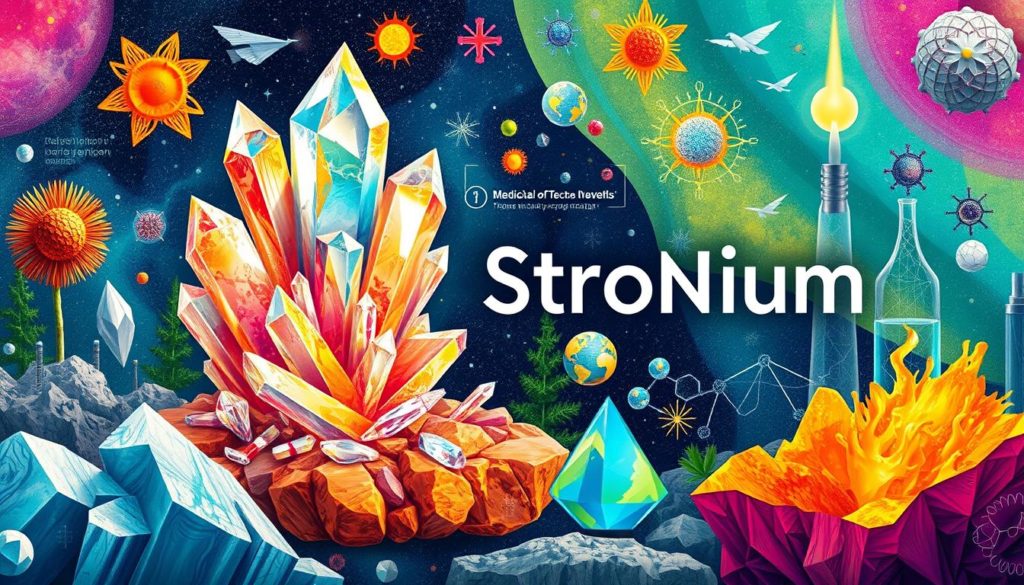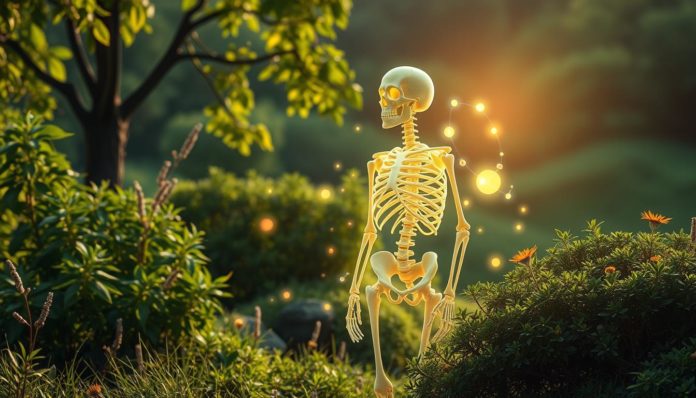Did you know that 90% of the strontium in our bodies is in our bones? This fact highlights its key role in keeping bones strong and healthy. Strontium is becoming popular because it might help improve bone density and treat conditions like osteoporosis.
Strontium is found naturally and plays a big role in health and wellness. It’s crucial for bone strength and is being studied for osteoporosis treatment. In this piece, we’ll look into how strontium supports bone health, its forms as supplements, natural sources, and recent research on it.
Introduction to Strontium
Strontium is found in Group 2 of the periodic table, designated by the symbol Sr and atomic number 38. It is among the alkaline earth metals. The discovery of Strontium traces back to 1790, thanks to Adair Crawford. He recognized it as a distinct mineral. This discovery started its journey of exploration and use in various areas.
Getting to know Strontium basics means understanding its physical and chemical traits. It looks silvery-white and reacts quickly with air. You can find Strontium in minerals like celestine and strontianite. Interestingly, Strontium acts a lot like calcium, which helps in medical uses.

The introduction to Strontium shows how useful this element is. It’s important in making ceramics and glass. For example, Strontium carbonate helps produce color TVs and monitors by blocking X-ray emissions.
Strontium is not just for industrial use; it also plays a key role in health. Specifically, it’s looked at for treating osteoporosis. This is through a compound called Strontium ranelate, showing how Strontium basics are important medicinally.
Strontium reacts with water, creating Strontium hydroxide and hydrogen gas. These reactions highlight why understanding its reactive nature is essential. Knowing this helps in safely using Strontium in different settings.
In conclusion, learning about Strontium covers its history, characteristics, how it’s used in industries, and its health benefits. This element has many interesting facets to explore thoroughly.
What is Strontium? A Comprehensive Overview
The Strontium chemical element has the symbol Sr and atomic number 38. It is an interesting topic in chemistry. This text gives a detailed Strontium overview. It talks about where it’s found, its isotopic makeup, and its different forms.
Strontium is found in the Earth’s crust and in seawater. It plays a big role in the environment and affects biological systems. For example, it can take the place of calcium in our bones and teeth. This affects how minerals form in our bodies. Let’s dive into the Strontium properties with this table:

| Characteristic | Description |
|---|---|
| Symbol | Sr |
| Atomic Number | 38 |
| Appearance | Soft, silver-white metal |
| Melting Point | 777°C (1431°F) |
| Boiling Point | 1382°C (2520°F) |
The Strontium overview wouldn’t be complete without talking about its four stable isotopes. We have Strontium-84, Strontium-86, Strontium-87, and Strontium-88. Each one has unique traits. They show why this element is so valuable in science and medicine.
To conclude, the Strontium chemical element is a very interesting topic. It touches on many parts of science and real-world uses. By learning about the Strontium properties, we can see its importance. It helps us in health and science discoveries.
Health Benefits of Strontium
Strontium has many health benefits, especially for bones. It helps keep bones strong and can be great at fighting osteoporosis. Besides those, it brings other health perks.
How Strontium Supports Bone Health
Scientists are very interested in how Strontium helps bones. It’s key for keeping bones dense and strong. Like calcium, it helps bones rebuild and stay healthy.
Strontium and Osteoporosis Management
Strontium is especially useful for treating osteoporosis. Studies show it can lessen the chance of fractures. It works by slowing bone loss and helping build new bone. This makes it a strong tool in managing osteoporosis.
Additional Health Benefits of Strontium
Strontium does more than just help bones. It can also reduce pain and swelling in bones and joints. Plus, it’s good for dental health and might even help your heart. This shows how versatile Strontium’s benefits are.
Strontium Supplements: What You Need to Know
Optimizing your bone health is key, and knowing about Strontium supplements helps. There are different types, each with unique benefits. It’s important to understand what each offers.
Types of Strontium Supplements
There are various Strontium supplement types for different health needs:
- Strontium Ranelate: This is popular in Europe for treating osteoporosis. It helps with bone growth and decreases bone loss.
- Strontium Citrate: In the U.S., it’s a top choice for bone health. You don’t need a prescription for it.
Choosing the Right Supplement
When you’re picking Strontium supplements, think about the dosage, purity, and extra ingredients. Here’s how:
- Dosage: Make sure to follow the label. Getting the right Strontium amount is crucial.
- Purity: Look for high purity and few additives. This means better absorption and less side effects.
- Additional Ingredients: Some options have extra vitamins and minerals, like Vitamin D and Calcium. These can boost the effects of Strontium.
Knowing these details can guide you through the choices out there. You can find the Strontium supplement that fits your health needs best.
Recommended Strontium Dosage
It’s key to know the recommended Strontium intake for health gains. Health experts and studies set guidelines for safe use. How much you need can change based on your health, age, and specific conditions.
To help bones stay strong, taking 680 mg of Strontium dosage daily is a common suggestion. This amount can improve bone density. For older adults with osteoporosis, a doctor might suggest a different amount.
| Health Condition | Recommended Strontium Dosage |
|---|---|
| Osteoporosis Management | 680 mg – 1,000 mg daily |
| General Bone Health | 680 mg daily |
| Post-Menopausal Women | 680 mg – 1,000 mg daily |
| Adults Over 50 | 680 mg daily |
Adjust your daily Strontium dosage based on your life stage and health needs. This makes sure you get the good effects and avoid risks. Always talk to a healthcare expert before changing your diet or supplements.
Potential Side Effects of Strontium
Strontium has many health benefits. But it’s key to know the side effects and risks. This knowledge helps you use it safely and with great effect.
Common Side Effects
Sometimes, strontium supplements may cause side effects. You might feel mild stomach upset, like nausea or diarrhea. Some people get mild skin issues or headaches. These side effects are usually brief and easy to manage. Just keep an eye on how your body reacts to strontium.
When to Consult a Doctor
It’s very important to know when symptoms are serious. If you have big health changes, like high blood pressure, allergic reactions, or heart problems, see a doctor right away. A healthcare pro can guide you. They’ll ensure you adjust your strontium use if needed.
For more details, check the table below. It lists both common and severe side effects of strontium:
| Type of Side Effect | Description |
|---|---|
| Gastrointestinal Discomfort | Includes nausea and diarrhea, usually mild and temporary. |
| Skin Irritations | Minor skin issues may occur, such as itching or mild rashes. |
| Headaches | Occasional, typically mild headaches can happen. |
| Severe Symptoms | Includes increased blood pressure, allergic reactions, and cardiovascular issues. Immediate medical attention is required. |
Natural Sources of Strontium
Strontium is present in many foods which helps with bone health. It’s essential to know where this mineral comes from and how much is in our food.
Food Sources Rich in Strontium
Strontium is often found in foods that are high in calcium. This includes seafood, grains, and dairy products. These are common in our daily meals. While the strontium in these foods might be low, adding them to your diet helps with mineral intake.
If you want more Strontium in your diet, supplements are an option. AlgaeCal’s Strontium Boost is a good source. It offers high amounts that are good for bones.
Other Natural Sources
Other than food, Strontium is also found in water and soil. The amount varies depending on the location. This affects the Strontium levels we get every day.
The soil and water quality influence how much Strontium we can get. Understanding these environmental factors helps us choose our diet wisely. This improves mineral intake and bone health.
The Latest Strontium Research
Recent studies in strontium research reveal different effects of strontium compounds. They particularly look at strontium citrate and strontium ranelate. Strontium ranelate shows significant health risks for people with osteoporosis, offering little benefit. This has led to the search for safer alternatives, making strontium citrate a key interest.
Research highlighted by Lara Pizzorno shows strontium citrate gets into the bone quickly. This means more strontium in the bones, which could help bone health over time. These results are promising, pointing to strontium citrate as a safer, better choice for bone health support.
For more in-depth details, check out the latest on strontium research at AlgaeCal’s blog here. Science keeps updating our understanding of strontium, its health benefits, and its groundbreaking possibilities. Staying updated with the latest research helps people make informed decisions about their bone health and wellness.
FAQ
What is Strontium?
Strontium is a naturally occurring element, found in both the Earth’s crust and seawater. It is linked with bone health and studied for osteoporosis benefits.
How does Strontium support bone health?
Strontium boosts bone health by promoting bone formation and boosting density. It strengthens bones by activating osteoblasts and blocking osteoclasts.
Can Strontium help in managing osteoporosis?
Yes, research proves Strontium supplements can enhance bone density and cut down fracture risks. Thus, they are helpful in treating osteoporosis.
What are the types of Strontium supplements available?
Strontium supplements come mainly as Strontium ranelate and Strontium citrate. Strontium ranelate is used in Europe, while Strontium citrate is in dietary supplements.
How do I choose the right Strontium supplement?
Choosing a Strontium supplement requires considering dosage, purity, and ingredients. It’s wise to consult a healthcare provider for tailored advice.
What is the recommended dosage for Strontium?
The dosage varies based on health goals and conditions. For bone health, doses range from 1000 to 2000 mg daily. Always consult a healthcare provider for personal advice.
Are there any side effects of taking Strontium?
Taking Strontium can lead to stomach upset, diarrhea, and nausea. Watch for adverse effects and see a doctor for persistent symptoms.
When should I consult a doctor about Strontium use?
Consult a healthcare provider if experiencing severe side effects, having pre-existing conditions, or taking other medications before starting Strontium.
Which foods are rich in Strontium?
Strontium-rich foods include leafy greens, root veggies, whole grains, some fish, and dairy products.
What are other natural sources of Strontium?
Strontium is also in soil and water. Strontium levels in natural resources vary by region, affecting dietary intake.
What is the latest research on Strontium?
Latest studies focus on Strontium’s bone health benefits and its role in osteoporosis treatment. Research also looks into its broader health impacts and safety.


